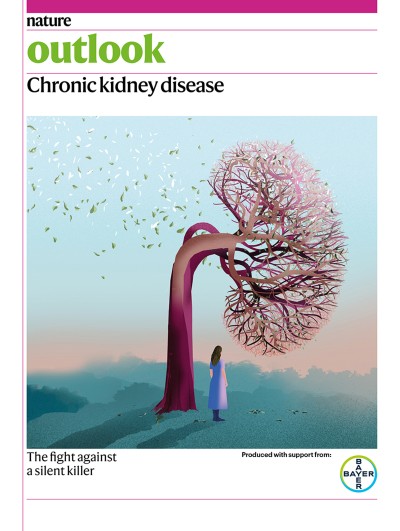Baby was a 38-year-old mother of four with end-stage kidney disease. She was vomiting, tired and needed dialysis three times a week. But in her town in northern India, the cost of therapy was prohibitive. Her daughters left school to save money, but still the family fell behind in their household expenses. All Baby could afford was one dialysis treatment each week. Eventually, even that became too costly. She stopped going for treatment, and died shortly after.
Vivek Jha, a nephrologist and executive director of the George Institute for Global Health, India, in New Delhi, contrasts Baby’s story with that of another of his patients: a 25-year-old roadside vendor with end-stage kidney disease. Jha told the man that his best bet for survival was a kidney transplant, but the father of two young children couldn’t afford it. “We thought he’d be another one of those who’d go home and die,” says Jha. Instead, some of the vendor’s colleagues asked Jha what they could do to help. The money they raised, combined with financing from local philanthropists and a kidney donated by the man’s mother, allowed him to get the surgery he needed.
Part of Nature Outlook: Chronic kidney disease
The average life expectancy of someone with end-stage kidney disease — also known as kidney failure — is around 15 years with a kidney transplant (it can be longer or shorter, depending on whether the kidney is from a living donor or not). Life expectancy for a person receiving dialysis is 5–10 years on average. Those who receive neither will die in less than a month. Transplantation, dialysis or death are the only options for people with kidney failure. Which of the three someone experiences is, by and large, determined by where they live, their socio-economic status, their education and their race. For end-stage kidney disease, the stakes are high and the equity gap is deep.
In most countries, organs from both living and deceased donors are in short supply. Dialysis, therefore, is the most common option for someone with kidney failure, and it’s far from ideal. Peritoneal dialysis uses a catheter in the abdomen to passively infuse solution over the course of at least eight hours. It’s usually done at home overnight, and requires storage space for the dozens of boxes of solution needed for a month of treatment, as well as a consistent power supply, a sanitary area for treatment and access to running water.
The alternative approach, haemodialysis, uses a machine to remove blood, filter it and then reinfuse the clean blood. The process requires the recipient to have surgery to create vascular access. Although this active process can be done faster and less often than peritoneal dialysis — three times a week for about four hours at a time — it is usually done at a dialysis centre and can leave people feeling exhausted for hours afterwards. In countries such as the United States that have few social safety nets, those hours also result in time away from work and lost wages, often requiring people to make difficult choices between their physical and financial security.
The rich get healthier
Varying wealth and health-care systems mean that countries tend to funnel people with kidney failure down different paths. In lower-income countries, that path is often conservative management: few or no dialysis centres and exorbitant treatment expenses mean that end-stage kidney disease is usually an imminent death sentence. Research has shown that only 1 in 100 people in sub-Saharan Africa who start dialysis will still be receiving treatment a year later1. Often they don’t realize that they’re signing up for a long-term commitment, Jha says. In some places, the time and cost of travelling to a free clinic can be too much for people to maintain. Many people travel great distances, thinking they’re headed towards a one-time, curative procedure. “When they get there, they realize that there is no cure,” Jha adds. “They will start dialysis, but very soon they realize that it’s not sustainable and they will drop off and die.”
In low- and lower-middle-income countries, kidney disease is the leading cause of ‘catastrophic health expenditure’ — when the medical spending of a household exceeds a certain threshold of capacity to pay. Almost everyone with kidney disease who receives accessible and sustainable treatment lives in high- or upper-middle-income countries2. Only around 7% of those who have access to dialysis and receive regular treatments are in low- or lower-middle-income countries, even though some of these countries are more populous than higher-income countries and have similar or higher rates of kidney disease compared with the rest of the world.
Even within upper-middle- and high-income countries, equity gaps persist. People with similar disease receive different treatments, and have different fates. This can depend not only on the country’s health-care system — private insurance compared with universal health care, or a focus on transplantation rather than dialysis — but also on the person’s location, their support network, their socioeconomic status, their race and their ethnicity.
“In any country, even if things are free, you have to depend on peoples’ health literacy and the safety they feel in accessing the health care system,” says Adeera Levin, executive director of BC Renal in Vancouver, Canada, an organization that oversees the care and allocation of kidney services in British Columbia. “And in any illness, the more resources you have as an individual — be they financial, intellectual or support services — then the more likely you are to do well.”
“In British Columbia, for instance, health care is free but we have a diverse geography,” says Levin, who is also a nephrologist at the University of British Columbia in Vancouver. “If you have to travel 100 miles to see a specialist, you’re not going to get the same care as if you have to travel three blocks.”
The United States has a different set of equity issues, mainly because its system of private health insurance means that those without coverage slip through the cracks. There is no universal coverage for preventing or delaying progression; only once someone has been diagnosed with kidney failure does the government step in, with Medicare — a federal programme for those over 65 or with certain disabilities — covering the cost of dialysis 90 days after starting treatment.
Many think, however, that this approach, is like trying to use a garden hose to put out a forest fire — it’s too little, too late. Interventions that can slow the progression of kidney disease, such as regular exercise, kidney-friendly diets, specific medications, and controlling blood glucose and blood pressure, are most effective when started earlier in the course of the disease. “All of the important stuff happens before you get on dialysis,” Levin says. In countries such as Canada that have universal health care, the system is set up to provide care every step of the way. “If you have kidney disease and you’re progressing, you get care,” Levin says, although she notes that there are geographical and socio-cultural limitations. The US approach of waiting until the end stages of disease to guarantee care “absolutely scuppers people from getting any prevention”, she says.
Silent killer
Even in countries that aim to detect kidney disease early, many people don’t receive treatment until their disease has progressed. “Kidney disease doesn’t give any specific symptoms until it’s too late in the game,” says Tushar Vachharajani, an interventional nephrologist at Wayne State University School of Medicine in Detroit, Michigan. It is, he says, “a silent killer”.
End-stage renal disease is typically defined as kidney function of less than 15% of typical levels. But people often don’t show symptoms until their kidney function has declined to below 20%. Such late symptom onset means that people without health insurance or regular care are less likely to be diagnosed and treated in time to prevent progression.
In the United States, those with the worst care are consistently people of colour. Research has shown that US dialysis facilities in communities where most residents are Black or Hispanic have poorer outcomes than would otherwise be expected3, regardless of the individual’s race and ethnicity, says nephrologist Deidra Crews, deputy director of the Johns Hopkins Center for Health Equity in Baltimore, Maryland. Crews thinks that factors at the community level probably have an important role — these could be limited access to other health care, healthy foods, services that support stable housing, or something else.
More from Nature Outlooks
When it comes to preventing the progression of kidney disease, Crews says, it’s clear that consistent health care makes a difference. An unintentional experiment for this exists in data from Medicaid — a public health-insurance programme for low-income individuals in the United States, and one that varies between states. A few years ago, with federal government funding, some states chose to expand their Medicaid coverage under legislation known as the Affordable Care Act. Crews points out that people who began their dialysis regime while living in states with this expanded Medicaid coverage had better survival than did those in states that did not expand4. Although the underlying reasons aren’t fully understood, the fact that these people have access to care before starting dialysis means that they are better positioned to maintain treatment. “We know that having coverage prior to dialysis initiation makes a difference,” Crews says.
Accessing dialysis can also be difficult for certain populations because it depends on factors that physicians often neglect to ask about, Crews says. Many people do not have a regular place to sleep, for example, or have little family or community support, or consistent access to food, let alone healthy options. “We make all sorts of recommendations for diet to people with end-stage kidney disease, but it’s almost impossible to follow that diet when you have a low income and you aren’t even sure when you’ll get a meal,” she says. “It’s a vicious cycle, because then people get labelled as non-compliant for the kidney-failure diet and are not considered eligible for things like transplantation.”
In an ideal world, one with universal access to preventive care, physicians could catch kidney disease early and slow its progress. Until then, dialysis remains a stop-gap solution — prolonging survival until donor organs become available. Dialysis is expensive, costing countries a disproportionate amount of their health-care budgets relative to the small number of people who need it. It’s also available only to those with the resources to access it and maintain that access, multiple times each week.
Until there are better medical options, Crews says, it’s essential to improve people’s access to care before the onset of kidney failure. Researchers are also looking to improve affordable access to dialysis for low-income individuals and countries. Back at the George Institute for Global Health, India, Jha and his colleagues are testing a portable, low-cost dialysis machine that they are aiming to get into clinics as soon as possible. They hope that by telling Baby’s story they can raise both awareness and funding, and that she and countless others will not have died in vain.



